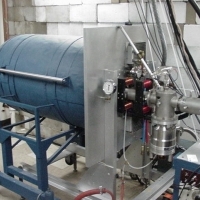
A 200KV Cockcroft-Walton accelerator is currently used for the SIRIS project under the supervision of Dr. Weathers.
Microprobe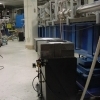
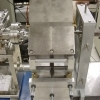
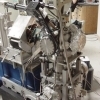
The major components of a high-energy, heavy ion, focused microprobe were purchased from MARC in Australia and the beam line, pumping system and analysis chamber were constructed at UNT. The microprobe began operating in September 1999. The nuclear microprobe beam line shares the 3.0 MV tandem accelerator with the 5 other beam lines. Currently, the major research projects are focused on the applications of Ion Beam Induced Charge Collection (IBICC), Ion Beam Induced Luminescence (IBIL) and Single Event Upset (SEU) techniques, which require a low beam current and a high spatial resolution (~ few mm).
A source of negative ions by cesium sputtering (SNICS) provides a wide variety of ion species (H, Li, B, C, Si, etc.). The second ion source is a NEC Alphatross for helium ions.
The microbeam line hardware consists of objective and aperture slits, probe-forming lens packages with a computerized focusing control system, a computerized beam scan unit, and a target chamber. The magnetic probe-forming lens system is the Russian-Quadruplet configuration, which gives a relatively high demagnification factor (~ 60). The advantage of higher demagnification means a larger size of the objective slits without sacrificing the spatial resolution; therefore, a larger beam current can be obtained.
In 2003 the target chamber was upgraded. The addition of better positioned ports allow for easier data acquisition. A turbo pump is used for the initial evacuation and an ion pump mounted at 90o is used when acquiring data. Analysis techniques and research include RBS, micro-PIXE, IBIC, IBIL and SEU.
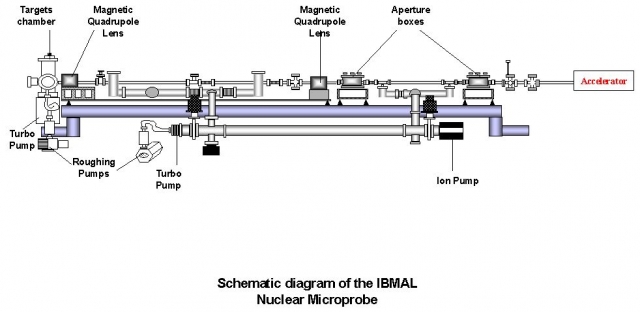
Constructed in late 2001 to replace an outdated line, it allows the researcher to perform a variety of analysis techniques including Rutherford Backscattering Spectometry (RBS), Elastic Recoil Detection (ERD), and Particle Induced X-ray Emission (PIXE) analysis. The beam line consists of a set of vertical and horizontal magnetic steerers, as well as a set of defining and anti-scattering slits. Also, the beam line is equipped with an Electo-Static Quadrupole Lens for focusing on light and heavy ions.
The target chamber is cylindrial in shape, with a height of 17cm and a radius of 16cm. There are nine free ports for feed-thoughts. A 16 slot rotatable sample holder is used for mounting targets, and a movable stand can house a surface barrier detector. For data acquisition, there are 2 PCs equipped with MCAs. The simple construction of the multipurpose beam line allows researchers to quickly change between analysis techniques.
Tandem Pelletron
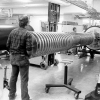
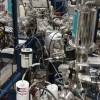
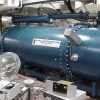
The National Electrostatics Corporation Model 9SDH-2 Pelletron is a 3MV tandem electrostatic accelerator. It is capable of accelerating a variety of ion species over a broad range of energies for use with RBS, PIXE, ion implantation and nuclear physics experiments.
The accelerator consists of a high voltage insulating support structure, a charging system which produces the high voltage and an evacuated acceleration tube with which the ion beam passes. In the center of the accelerator is the high voltage terminal and to either side are the low energy and high energy acceleration tubes.
Negative ion beams produced in a negative ion source are pre-accelerated to modest energies(50 keV) before being injected into the 9SDH-2. The beam enters what is referred to the as the low energy end of the accelerator where the negative ions are attracted to the positively charge high voltage terminal and are thus accelerated. Once inside the ions enter a "stripper" where they are stripped of electrons and are converted to positive ions. In the case of molecular ions, disassociation also occurs. As these positive ions exit the stripper and drift into the second stage of the accelerator they are repelled by the high voltage terminal and thus accelerated once again.
This dual acceleration gives the singly charged ions twice the energy they would acquire in the single stage accelerator have the same terminal voltage, and gives ions with a charge state +n a final energy of (n+1) eV, where is the electronic charge and V is the terminal voltage. ---NEC
The NEC Pelletron is the primary accelerator here at IBMAL. It provides acceleration for the TEAMS, microprobe, ion implantation and multi-purpose beam line.
Trace Element Accelerated Mass Spectrometry (TEAMS)
Trace element AMS employs an ultra clean Negative Ion Cs Sputter Source to sputter negative ions from a target. The negative secondary ions are extracted and focus. They are then injected into the tandem accelerator. At the terminal, the atomic molecular secondary ions from the sample are stripped of a number of electrons in a gas or foil stripper. The electron stripping causes molecular break-up through a Coulomb explosion into elemental ions, which are accelerated to higher energy and exit the accelerator. If the diatomic or triatomic molecular ion is stripped to a 3+ or greater charge state, almost all molecules break up into elemental constituents.
With TEAMS the resulting atomic ions, which are in a number of different charge states with correspondingly different energies, are extracted from the high-energy end of the tandem accelerator. These atomic ions are then magnetically analyzed for momentum/charge (mv/q) and electrostatically analyzed for energy/charge, which together gives mass/charge (m/q) discrimination. To eliminate interferences from the possible break-up fragments that have the same m/q, the energy of the ion is measured in a surface barrier detector or ionization chamber.
Typical sensitivities are on the order of 0.1ppb in depth-profiling mode and 5 ppt in the bulk analysis mode. Theoretical sensitivities of 1ppt are expected under ideal conditions.
Van de Graff #1
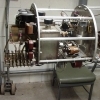
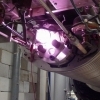
One of the older accelerators in our lab, the 2.5 MV Van de Graaff still remains useful as a undergraduate and first your graduate training tool. It allows us to perform PIXE, RBS, and a variety of other analysis techniques, when the Pelletron is being used for other purposes. It is also used for ion implanting H, or He.
The beam line is simple, consisting of vertical and horizontal magnetic steerers, as well as a set of defining and anti-scattering slits. The beam line is also equipped with an Magnetic Quadrupole Lens for focusing of light and heavy ions.
The target chamber is virtually identical to that found of the MBL (Multi-purpose beam line), with the addition of a smaller chamber which houses a goniometer for channeling experiments.
In 2003 an additional beam line was added to the VG specifically for implanting H or He.
Van de Graff #2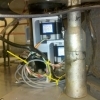
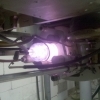

The second Van de Graaff is located in Room 010 of the Physics building, and is currently being upgraded. Under the supervision of Dr. Matteson and Dr. Weathers, the accelerator will be configured for proton resonance NRA study of Flint and Chert.

